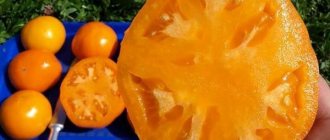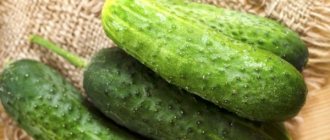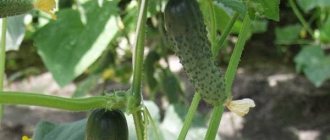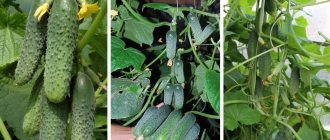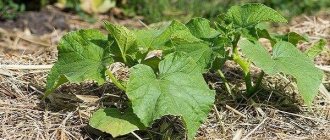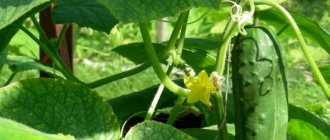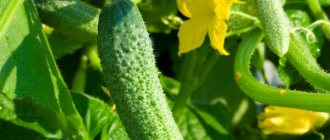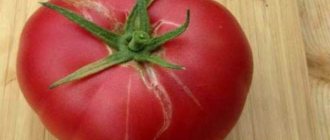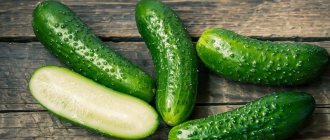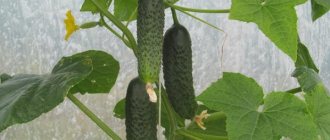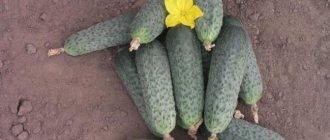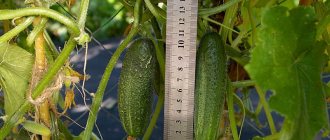Cucumber Three tankers f1 has joined the ranks of early-ripening hybrids that produce a rich harvest of small gherkin cucumbers. Like all similar hybrids, it is easy to care for, produces greenery in whole bunches and never lets the gardener down.
| Landing location | Ripening time | Mode of application | Fruit length | Group | Fruit smoothness | Pollination method |
| Universal | Early ripening (35-45 days) | Universal | Medium - from 10 to 15 cm | Hybrid | Highly lumpy | Parthenocarpic |
Cucumber variety Three Tankers f1
When growing cucumbers on their plots, some summer residents prefer only varietal varieties of this vegetable crop, while others prefer only hybrids. Each of the adherents of cucumber varieties or hybrids give their own arguments in favor of their favorite variety.
But before you purchase this or that type of cucumber seed product, you need to get acquainted with the description of this vegetable crop in order to get an idea of its main characteristics, cultivation rules and other nuances.
This article will talk about the cucumber hybrid Three Tankists, a description of this vegetable, and many other positive qualities of the plant will be given.
The content of the article:
1. Main characteristics and description of the variety
2. Agricultural technology for growing cucumbers THREE tankers F1
3. Advantages and disadvantages
4. Cucumber Three tankers f1 - reviews from those who planted
5. Characteristics from the manufacturer
Cucumbers THREE tankers: description of the variety
Cucumber Three tankers f1 is recommended by breeders for cultivation in open ground or in greenhouses in many regions of Russia.
This hybrid is intended for growing in gardens, personal farmsteads and small farms.
Its main characteristics will be discussed below.
This parthenocarpic hybrid belongs to the indeterminate type. The central shoot of this variety can grow unlimitedly; gardeners usually pinch its top to stimulate the growth of lateral stems. The height of the central stem is greater than that of the side stems and can be up to 1.7-1.9 m. The number of side shoots is average. The foliage is medium in size, slightly wrinkled, the edges are slightly wavy, rich emerald color.
The best varieties of cucumbers!
• Early cucumbers GERMAN F1 • Long greenhouse cucumbers EMERALD STREAM F1 • Late ripening cucumbers PHOENIX
On the stems, predominantly female flowers are formed, there are no or almost no male flowers.
The flowers of this hybrid do not require pollination; there are no seeds inside the ripened greens, or they can only grow to the stage of milky ripeness. Experts classify the gherkin hybrid Three Tankist f1 as an early-ripening cucumber - no more than 1.5 months pass from the moment the sprouts appear until the ripe greens are harvested.
Flowers collected in bunches appear in internodes; each of them can form from 2 to 5 ovaries. On the side stems, in the internodes, bunches of 4 ovaries are formed. The shape of ripe fruits can be spindle-shaped or cylindrical. The cucumber variety Three Tankists belongs to the gherkin type, so the maximum size of green cucumbers is 10-11 cm, and the diameter is no more than 3.5 cm. The weight of each ripe fruit is 100-110 g. The skin of cucumbers is dense, crispy, covered with small tubercles and whitish spikes. Thin, rather long, thin light stripes are visible on the surface of the greens.
Cucumber Three Tankmen photo
Cucumber Three tankers variety yield
Productivity of an early ripening hybrid Three tankers - about 13 kg per square. The taste of ripe gherkins is good. The presentation of cucumbers is excellent, which does not deteriorate even when transported over long distances.
Collected greens are for universal purposes, Three Comrades cucumbers can be consumed fresh, for making salads, as well as for pickling and pickling. Many summer residents prefer to pickle gherkins, since their taste does not deteriorate and the cucumbers remain tasty and crispy.
Hybrid Three Tankers is resistant to a number of diseases that affect other varieties of cucumbers:
- to cucumber mosaic virus;
- root rot;
- powdery mildew;
- olive spot.
Important! Ripening gherkins should be removed regularly, then new ovaries will more actively form on the vines.
Agricultural technology
The hybrid is planted in May, as the plant is highly sensitive to low temperatures. Plant crops are grown by seedlings or by directly planting seeds in the ground in a permanent place. When cultivating seedlings, seeds are planted in pots filled with soil. At the stage of formation of 3 true leaves, the sprouts are sent to the garden. Seedlings are arranged at intervals from each other. Cucumbers are very sensitive to transplantation, so experts advise taking special peat pots for propagating seedlings. When transferring to the garden, seedlings do not need to be removed from the container.
Young shoots must be guaranteed:
- full lighting;
- optimal temperature level;
- normal humidity.
In the soil, the peat pot decomposes and turns into an additional source of organic matter, feeding the plant. There is no trauma to the rhizome. It is necessary to plant crops in well-lit areas. Do not thicken the plantings. To form a strong bush at the level of 3 leaves, cut off the shoot.
Note!
Direct sowing into the soil makes the process of growing the variety easier. The only negative is that cucumbers begin to ripen 1.5-2 weeks later.
When planting in the holes add:
- humus;
- wood ash.
After sowing, the area is covered with PE to create a greenhouse. The shelter is removed after the seeds hatch. Caring for the plant is easy. Water with warm water 2-3 times every 7 days in the evening. To distribute the liquid evenly, it is important to use the drip irrigation method. Cucumbers love to be fertilized with organic matter, but not overfed. To ensure full fruit yield, potassium is added.
An excess of organic matter can negatively affect the plant and yield. Complex formulations containing nitrogenous substances are suitable as additional nutrition. To ensure the normal formation of the plant and prevent fungal damage, it is important to carry out:
- loosening the soil;
- hilling.
You may be interested in:
These measures regulate the balance of oxygen and fluid and ensure their access to the rhizome. It is recommended to tie the lashes to trellises. At the same time, full growth and the supply of oxygen masses to the above-ground part of the plant crop are guaranteed. Features of agricultural technology:
- Sowing - March-April, June.
- Sowing scheme - 3-4 plants/m2.
- Sowing depth is 1.5-2 cm.
- The harvesting period is May-October.
- Recommended planting: sow seeds after the threat of night frosts, when the soil warms up to 10-12 o
Plantings must be freed from weeds, this allows the plant to receive all the necessary nutrients.
On a note!
Growing cucumber crops can be done on almost all types of soil that have sufficient aeration and drainage, but it is better to use light soils rich in humus.
Ideally, you need to choose a place where pumpkin crops did not grow even last year:
- Cucumbers.
- Patissons.
- Zucchini.
- Pumpkin.
This is required to avoid the accumulation of diseases and parasites. However, a change of place once every 5 years is also allowed. When cultivated, cucumbers require an even and constant supply of fertilizers. The hybrid responds well to fertilizing with organic matter, which improves the soil structure.
Planting cucumbers requires preparing the beds in advance. It is recommended to prepare soil for seedlings in the fall. The area must be dug up to a depth of 220-270 mm, and slurry and humus must be added to the digging at the rate of 10 liters per 1 m2. In the next 2-3 years, you should not add organic matter, then only minerals.
Cucumbers Three tankers f1: planting, growing and care
This hybrid should be planted in the same way as other varieties of cucumbers; when planting and growing, the following requirements must be observed:
- You only need to water the cucumbers with warm filtered or settled water. It is better to carry out this procedure in the evening;
- When applying fertilizing, you need to remember that cucumbers are very responsive to organic matter, so most often summer residents use a solution of cow manure or bird droppings. It is better to fertilize cucumber Three Comrades immediately after watering, so as not to burn the tender roots of the plants. The main thing is to follow the dosage, since excess fertilizer is just as bad for cucumbers as its lack. Fertilizing with organic matter should be alternated with the application of complex mineral fertilizers;
- the soil around the bushes must be loosened after each watering to remove the crust that forms on the surface of the earth, while simultaneously removing all weeds;
The best cucumber varieties!• High-yielding hybrid BERENDEY F1 • Early cucumbers BOBRIC F1 • Cucumbers DIRECTOR F1
- This hybrid is best tied to trellises or a specially stretched cucumber net. In this case, it is easier to care for the bushes and also to collect ripening greens.
You can grow these cucumbers by directly planting seeds in open ground, or by seedlings.
When growing seedlings, it is better to plant Three Comrades cucumber seeds one at a time in peat pots, together with which the plants are transplanted to a permanent place. With this planting, cucumbers do not injure their delicate root system. Further care for Three Comrades cucumbers is standard - as for other cucumber varieties.
Agricultural technology
The hybrid is planted in May, as the plant is highly sensitive to low temperatures. Plant crops are grown by seedlings or by directly planting seeds in the ground in a permanent place. When cultivating seedlings, seeds are planted in pots filled with soil. At the stage of formation of 3 true leaves, the sprouts are sent to the garden. Seedlings are arranged at intervals from each other. Cucumbers are very sensitive to transplantation, so experts advise taking special peat pots for propagating seedlings. When transferring to the garden, seedlings do not need to be removed from the container.
Young shoots must be guaranteed:
- full lighting;
- optimal temperature level;
- normal humidity.
In the soil, the peat pot decomposes and turns into an additional source of organic matter, feeding the plant. There is no trauma to the rhizome. It is necessary to plant crops in well-lit areas. Do not thicken the plantings. To form a strong bush at the level of 3 leaves, cut off the shoot.
Note!
Direct sowing into the soil makes the process of growing the variety easier. The only negative is that cucumbers begin to ripen 1.5-2 weeks later.
When planting in the holes add:
- humus;
- wood ash.
After sowing, the area is covered with PE to create a greenhouse. The shelter is removed after the seeds hatch. Caring for the plant is easy. Water with warm water 2-3 times every 7 days in the evening. To distribute the liquid evenly, it is important to use the drip irrigation method. Cucumbers love to be fertilized with organic matter, but not overfed. To ensure full fruit yield, potassium is added.
An excess of organic matter can negatively affect the plant and yield. Complex formulations containing nitrogenous substances are suitable as additional nutrition. To ensure the normal formation of the plant and prevent fungal damage, it is important to carry out:
- loosening the soil;
- hilling.
You may be interested in:
These measures regulate the balance of oxygen and fluid and ensure their access to the rhizome. It is recommended to tie the lashes to trellises. At the same time, full growth and the supply of oxygen masses to the above-ground part of the plant crop are guaranteed. Features of agricultural technology:
- Sowing - March-April, June.
- Sowing scheme - 3-4 plants/m2.
- Sowing depth is 1.5-2 cm.
- The harvesting period is May-October.
- Recommended planting: sow seeds after the threat of night frosts, when the soil warms up to 10-12 o
Plantings must be freed from weeds, this allows the plant to receive all the necessary nutrients.
On a note!
Growing cucumber crops can be done on almost all types of soil that have sufficient aeration and drainage, but it is better to use light soils rich in humus.
Ideally, you need to choose a place where pumpkin crops did not grow even last year:
- Cucumbers.
- Patissons.
- Zucchini.
- Pumpkin.
Advantages and disadvantages of the Three Comrades F1 variety in comparison with other cucumber crops
Vegetable growers include the main advantages of this hybrid:
- ripe fruits - gherkins, even in size and shape;
- early ripeness of the hybrid;
- good taste and excellent presentation of the collected gherkins;
- versatility of the harvested crop;
- Three Tankist cucumbers are resistant to most diseases;
- The variety does not require pollination.
The hybrid has no obvious disadvantages, but it should be noted that it will not be possible to collect seeds from cucumbers of the Three Tankers variety, so planting material will have to be purchased annually. To make it easier to care for the bushes and collect ripe fruits, the lashes require tying.
Cucumbers Three Tankmen video
Cucumbers Three tankers - reviews of those who planted
Based on the reviews of those farmers who have already planted this variety, you can better form your opinion about Three Tankist cucumbers, so some of them are given below:
Olesya, 40 years old: this gherkin hydrid has been grown at their dacha for several years now - I am pleased with the ease of caring for the bushes of these cucumbers, as well as the early ripening of the fruits. Gherkins are very tasty, crispy, their taste does not deteriorate when salted or pickled.
Elena, 38 years old: I liked the Three Tanker cucumbers because of the quick yield of the harvest - 1.5 months after the emergence of shoots, we were already eating ripe fruits from our garden. The harvest was large enough - enough for both food and canning. I will grow this hybrid in future seasons.
Olga, 44 years old: I liked this hybrid for its positive qualities - productivity, early ripening, good taste, as well as the resistance of the bushes to most diseases. The only drawback is that you cannot collect seeds from the bushes for further planting, so every spring you have to buy seed material again.
Those who have already planted this early-ripening hybrid are quite satisfied with its positive qualities, so they say that those who have grown Three Tanker cucumbers at least once will plant it in the future. This is the best recommendation for a hybrid.
We will be glad to receive your feedback about the Three Tankmen f1 cucumbers, which you can leave in the comments.
Cucumber THREE tankers: description and characteristics from the manufacturer
Cucumber Three tankers F1 is a highly productive early ripening parthenocarpic bunch gherkin hybrid for open ground, spring greenhouses, tunnels. It has a friendly massive yield of yield. Fruiting lasts until late autumn. Photophilous, medium branching. From 2-3 to 4-5 ovaries are formed in the nodes.
The greens are tuberculate, white-thorned, often with medium pubescence, bright green in color, 9-12 cm long. Pickling, canning and taste qualities are very high. The hybrid is resistant to powdery mildew, olive spot, common cucumber mosaic virus, and tolerant to downy mildew and root rot.
Planting density in greenhouses is 2.5 plants/m2, in open ground 3-4 plants/m2.
Advantages of a hybrid
The cucumber variety Three Tankers f1 belongs to the first generation hybrids and is included in the State Register of Breeding Achievements. The variety is intended for cultivation in open ground and spring tunnels. Three tankers cucumbers are grown on personal plots and in small farms.
Parthenocarpic (self-pollinating) cucumber is capable of producing fruits without seeds. This is an early ripening variety with a growing season of 40-43 days; is characterized by high productivity.
The plant is an annual, indeterminate type, vigorous, with an average number of branches. The leaves are medium in size, green, slightly wrinkled, slightly wavy at the edges.
The description of the hybrid indicates the formation of predominantly female peduncles. Each node ripens 2-3 fruits, and on the side shoots - up to 4 gherkins.
Cucumbers have a cylindrical, spindle-shaped shape, a slightly glossy skin, large tubercles, and white spines. The fruits have a slightly ribbed surface, green color with short stripes, and white pubescence.
Read also: Tomato midas characteristics and description of the variety
The length of ripe gherkins reaches 6-8 cm, diameter - 3.1-3.4 cm. The weight of the greens reaches 90-110 g. The commercial yield of the hybrid is 10-13 kg per 1 m².
Reviews from vegetable growers indicate excellent taste and universal use in cooking. Cucumbers are used fresh, for making salads, pickling, and canning.
Pickled cucumbers are considered a delicacy and have exceptional taste. These cucumbers contain a concentrated amount of minerals. Gherkins are a major component of the cucumber diet.
The hybrid is resistant to cucumber mosaic virus, root rot, powdery mildew, and olive spot.
Ripe cucumbers must be removed from the plant in a timely manner to stimulate the development of other ovaries.
